When you try to run certain Finance Fiori Apps for the fist time in a brand new environment, you might get an error message after opening the App related to the "Fiscal Year variant". This is due to some missing records in Table FINSC_PERIOD. If you look at this table for your Fiscal Year variant, most likely you will not have any records for it.
" ... In some Fiori Apps like the "Trial Balance" or in apps using the Date Picker component, information about the fiscal calendar date or the fiscal year periods is used. This information is taken from the tables FINSC_FISC_DATE and FINSC_PERIOD or the CDS views I_FiscalCalendarDate and I_FiscalYearPeriod. At the moment these tables have to be filled manually by executing the report FINS_GENERATE_FISCAL_PERIOD. Additionally they will later be filled automatically by the balance carried forward ..." (As per OSS Note 2268557)
So you will have to execute Program FINS_GENERATE_FISCAL_PERIOD to fix this issue. The program will analyze the Fiscal Year variant that you input (+ some other parameters) and will write records in Table FINSC_PERIOD. After that, your Finance Fiori apps will not give you an error anymore.
Under normal circumstances, this Table FINSC_PERIOD is supposed to be filled by the Balance Carry Forward program (FAGL_GVTR), but if you are in an environment where you have never run the Balance Carry Forward before, this Table will be missing those records. So you have to a program to fix it manually.
As usual, to run a program. Go to Tcode SE38 / SA38 and enter the program name and Execute. (Note: this program has its own Tcode too OB_FCAL)
These are the options that you need to put in Program FINS_GENERATE_FISCAL_PERIOD.
- Your Fiscal Year Variant (Ex. Z1).
- Fiscal Year (Actual Fiscal year).
- Offset before Fiscal Year (how many FYs you want to go in the past to write this records).
- Offset after Fiscal Year (how many FYs you want to go in the future, I recommend at least 50 years).
- Execute.
After executing, Table FINSC_PERIOD will have new records for your Fiscal Year variant (Ex. Z1) with 1 record per Fiscal Year period (month) indicating the exact Calendar Date for the Start and End of the Period among some other Data.
As mentioned before these records will be used by some Fiori Apps and will also be used in Analytics in CDS Views as well.
OSS Notes
Finally in case you need to clean up the values in Table FINSC_PERIOD, OSS Note 2734266 has a clean up custom code delivered by SAP to delete those records so you can run the generation again.
Give this OSS Note to an Abaper so he can create the Custom delivered program for you to rund it (ZCLEAN_FISCAL_TABLES).
Why would you want to do something like that ? I will tell you a real life anecdote.
My client had a FY Variant Feb to Jan but was also running 4-4-5 (Year dependent). So its own periods where also irregular and not following the calendar. Example: Period 1 instead of finishing on Feb-28, was finishing Feb-26, so Feb 27th was already part of Period 2.
We had setup Fiscal Years already in the future for a couple of years to come, but later on during the project, their Finance organization decided to simplify their things and changed the periods to align them with the Calendar. So, after that Period 1 was really finishing on Feb-28.
Because of that we already had records in Table FINSC_PERIOD but the system was not properly determining the new Start and End dates of each period (in certain places) because it was using the old and wrong data from FINSC_PERIOD. Not in all the case was using the traditional Tables T009 and T009b to determine the Periods.
So we implemented this custom code, we executed, cleaned up the Table and re-executed FINS_GENERATE_FISCAL_PERIOD.
Ex. One of the places where we were seeing the impact of this was on "Settlements" that was determining the wrong day as it is always posting at the last day of the month any Journal Entry deriving from the Settlement process.
*Note: This issue only applies to S/4 HANA versions, it does not apply to ECC6.0.
If your Company and/or Project needs to implement this, or any of the functionalities described in my Blog, or advise about them, do not hesitate to reach out to me and I will be happy to provide you my services.










